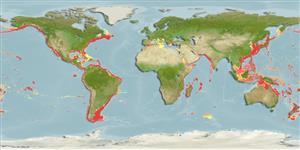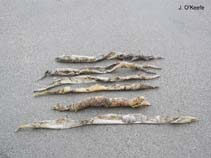Chaetopterus variopedatus Cuvier, 1827
Fairy tubeworm| Native range | All suitable habitat | Point map | Year 2050 |

|
| This map was computer-generated and has not yet been reviewed. |
| Chaetopterus variopedatus AquaMaps Data sources: GBIF OBIS |
رده بندی / Names اسامي عام | مترادف | CoL | ITIS | WoRMS
Polychaeta | Canalipalpata | Chaetopteridae
Environment: milieu / climate zone / تغييرات عمق / distribution range بوم شناسي
; تغييرات عمق 1 - 585 m (مرجع 87630). Tropical
Distribution كشورها | مناطق سازمان خوار و بار جهاني (FAO) | Ecosystems | ظهور | معرفي
Antarctic, Atlantic, the Mediterranean and Indo-Pacific. Tropical to polar.
Length at first maturity / Size / Weight / سن
بلوغ: Lm ? range ? - ? cm
Life cycle and mating behavior بلوغ | تولید مثل | تخم ریزی | Eggs | Fecundity | Larvae
مآخذ اصلی
مراجع | هماهنگ كننده | همكاران
Gibbs, P.E. 1978 Macrofauna of the intertidal sand flats on low wooded islands, Northern Great Barrier Reef. Philosophical Transactions of the Royal Society of London, Series B 284(999):81-97. (مرجع 3197)
وضعيت در فهرست قرمز IUCN
(مرجع 130435: Version 2025-1)
وضعيت از نظر سايتس (مرجع 108899)
CMS (مرجع 116361)
خطر برای انسان ها
استفاده انسانی
| FishSource |
ابزارها
اطلاعات بيشتر
منابع اينترنتي
BHL | BOLD Systems | CISTI | DiscoverLife | FAO(Publication : search) | Fishipedia | GenBank (ژنوم, نوکلئوتيد) | GloBI | Gomexsi | Google Books | Google Scholar | Google | PubMed | Tree of Life | Wikipedia (برو, جستجو) | Zoological Record



